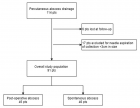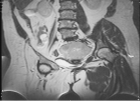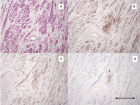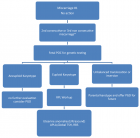About University of Sfax
University of Sfax
Articles by University of Sfax
An exceptional case of bilateral vestibular areflexia complicating acute otitis media
Published on: 2nd July, 2020
OCLC Number/Unique Identifier: 8627247898
Introduction: Bilateral vestibular areflexia is a rare pathological entity whose most frequent etiology is drug ototoxicity. We report an unusual case of bilateral vestibular areflexia complicating acute otitis media through which we raise the difficulties of diagnosis and therapeutic management of this pathology.
Case Report: 57-year-old Tunisian patient who consults for a loss balance associated with earache and hearing loss. Initial clinical examination revealed bilateral acute otitis media with a right harmonious vestibular syndrome and normal neurological examination. The diagnosis of post-otitis labyrinthitis was retained. The patient was put on antibiotics and corticosteroids. The evolution was marked by the persistence of instability in darkness and oscillopsia; vestibular explorations concluded with bilateral vestibular areflexia. MRI concluded to posterior labyrinthitis and eliminated central neurological involvement. The patient was kept under betahistine. The tympanic cavity was drained by a tympanic aerator on both sides. Vestibular rehabilitation was started quickly. Gradual improvement was obtained of autonomy with persistent oscillopsia.
Conclusion: Bilateral vestibular areflexia poses diagnostic problems based on anamnestic and clinical arguments and vestibular explorations. The therapeutic management is delicate, vestibular reeducation occupies a primordial place.
The inflammatory profile of chronic kidney disease patients
Published on: 20th December, 2021
OCLC Number/Unique Identifier: 9396216755
Background: Chronic kidney disease is a worldwide public health issue which is associated with an increased risk of end-stage renal failure and cardiovascular disease. Systemic inflammation exists during chronic renal failure. Recent researches have highlighted the pivotal role of inflammation between renal and cardiovascular disease. The aim of our study is to determine the inflammatory profile of the patient suffering from chronic kidney disease and the influence of hemodialysis on this profile.Methods: We carried out a cross sectional study on 93 patients in the Nephrology Department at Hedi Chaker University Hospital, Sfax, South of Tunisia. Among those patients, 72 patients underwent hemodialysis and 21 patients had chronic kidney disease at stage 3. Clinical data and antecedents were collected. Biological samples were taken after informing the patients and taking their consent. Biological data consisted in lipid profile, albumin rate, hemoglobin rate, uric acid concentration and the usual markers of inflammation noting sedimentation rate, C - reactive protein and orosomucoid.Results: Hemodialysis group of the 72 patients had mean hemodialysis vintage of 54.6 ± 43 months. The inflammatory profile was worse in hemodialysis patients compared to chronic kidney disease patients. Both sedimentation rate, C - reactive protein and orosomucoid were higher in hemodialysis group than in chronic kidney disease group with 71 ± 35.3 mm vs. 42.1 ± 15.5 mm (p < 0.05); 14.6 ± 28.7 mg/l vs. 6.7 ± 8 mg/l (p = 0.02); 1.3 ± 0.7g/l vs. 0.9 ± 0.4 g/l (p = 0.01), respectively.Conclusion: Inflammation increases in dialysis patient. It deserves the nephrologist’s consideration in order to minimize its harmful effects. The monitoring of inflammation markers must be integrated into the nephrologist’s medical practice.
The thoracoscopic approach in the management of parapneumonic pleural effusion in children
Published on: 23rd December, 2022
Background: Parapneumonic pleural effusion is a relatively common entity and continues to be a major cause of morbidity in children. However, managing this disease is still a matter of controversy between surgical and non-surgical options. With the advancement of mini-invasive surgery, video-assisted thoracoscopic surgery (VATS) has become a mainstay in the treatment of parapneumonic effusion in children. This study aimed to evaluate the clinical characteristics and pathological features of parapneumonic pleural effusion in children and to explore the feasibility and safety of the thoracoscopic approach in the pediatric population.Methods: The clinical data of all patients who underwent VATS for parapneumonic effusion between 2007 and 2021 were analyzed retrospectively. Factors that were documented included demographic criteria, clinical manifestations, preoperative examinations, therapeutic procedures, intraoperative findings, postoperative complications, and outcomes.Results: Totally, 35 patients with a mean age of 5.14 ± 3.9 years were operated on thoracoscopically. The mean duration of evolution before VATS was 9 days ± 4. All children were hospitalized in a Pediatric Continuing Care Unit. Antibiotic therapy was administrated in combination in all cases. Corticosteroid therapy was used in 2 patients. Thoracentesis was performed in 6 patients. Thoracostomy tube drainage was placed before surgery in 11 patients. The average duration of drainage before VATS was 6 days ± 4. VATS decortication and/or debridement was indicated as second-line in 23 patients. The average duration of the surgery was 51 minutes (20 min - 115 min). There is no conversion to open surgery and no intraoperative procedure-dependent complication. 4 children have early complications after the VATS and one patient had a late postoperative complication. There were no deaths during the hospital stay or follow-up. Conclusion: In skilled hands, VATS is safe, feasible, and effective in the management of parapneumonic pleural effusion in children with excellent outcomes.
Vesicovaginal fistula: an uncommon complication of a perineal burn in a 12-year-old girl
Published on: 18th January, 2023
Perineal burns are a rare finding in children that may cause severe complications. Vesicovaginal fistulas are an uncommon complication of a perineal burn that can be a tragedy for girls suffering from them. Fistula and/or its treatment are a socially debilitating problem with significant medicolegal implications. We present a rare case of a girl with a history of traumatic perineal burns who was diagnosed with a vesicovaginal fistula and repaired through a transvaginal approach.
Detection of extended-spectrum betalactamase and carbapenemase-producing Enterobacteriaceae in Tunisia
Published on: 15th March, 2023
The emergence of dramatic urinary tract infections (UTIs) caused by the members of the Enterobacteriales is an important public health problem in the community as well as in Tunisian hospitals. This study aims to investigate the prevalence of extended-spectrum β-lactamase (ESBL) and carbapenemase-producing uropathogenic isolates of Escherichia coli (E. coli) and Klebsiella pneumoniae (K. pneumoniae). Based on decreased susceptibility to β-lactams antibiotics and analyzed for the presence of ESBL and carbapenemase genes by Real Time- polymerase chain reaction (RT-PCR), 56 uropathogenic isolates of E. coli (n = 36) and K. pneumoniae (n = 20) were confirmed positive for ESBLs. The CTX-M-type β-lactamases were mostly detected in E. coli isolates (21 strains, 58.33% [95% CI 38.09% - 72.06%]) followed by blaSHV-like (18 strains, 50% [95% CI 32.92% - 67.07%]), blaTEM-like and blaCMY-2-like simultaneously (15 strains, 41.67% [95% CI 25.51% - 59.24%]). Furthermore, the RT-PCR system on the K. pneumoniae strains demonstrated that blaSHV-12-like was the most predominant (16 strains, 80% [95% CI 56.33% - 94.26%]) followed by blaTEM-like (14 strains, 70% [95% CI 45.72% - 88.10%]), blaCTX-M belonging to groups 9 and 1 (11 strains, 55% [95% CI 31.52% - 76.94%]) and finally blaCMY-2-like (10 strains, 50% [95% CI 27.19% - 72.80%]). In addition, E. coli and K. pneumoniae strains harbored a carbapenemase gene blaOXA-48-like with 22.2% [95% CI 10.11% - 39.15%]; 20% [95% CI 12.83% - 43.66%], respectively.Our results confirm the need to monitor the resistance to extended-spectrum β-lactams and to carbapenems among enterobacteria in Tunisia.

HSPI: We're glad you're here. Please click "create a new Query" if you are a new visitor to our website and need further information from us.
If you are already a member of our network and need to keep track of any developments regarding a question you have already submitted, click "take me to my Query."
























































































































































